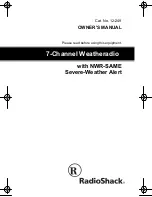
1-1
November 1999
Part No. 001-7780-500
GENERAL INFORMATION
SECTION 1 GENERAL INFORMATION
1.1 SCOPE OF MANUAL
This service manual contains operating, program-
ming, alignment, and service information for the E.F.
Johnson 7780 800 MHz portable transceiver.
1.2 EQUIPMENT DESCRIPTION
1.2.1 INTRODUCTION
The 7780 800 MHz portable transceiver is avail-
able in limited keypad (3-key) and full keypad (15-
key) models. In addition, standard and intrinsically
safe versions are available (see Section 1.2.3). With all
versions, up to 16 zones can be programmed, and each
zone can contain up to 16 channels resulting in up to
256 total channels. The rotary switch on the top panel
provides channel select, and an option switch provides
zone select if applicable.
The 7780 is an 800 MHz transceiver which oper-
ates on the 920 channels from 806-824 MHz (mobile
transmit). The receive channels are 45 MHz above
these frequencies from 851-869 MHz. All models can
be programmed for both narrow and wide band opera-
tion. With narrow band operation, the channel spacing
is 12.5 kHz and maximum deviation 2.5 kHz; with
wideband operation, the channel spacing is 25 kHz
and maximum deviation is 5 kHz. On NPSPAC chan-
nels, maximum deviation is 4 kHz (see Section 1.2.5).
1.2.2 OPERATING PROTOCOLS
The 7780 operates on analog channels utilizing
the following operating protocols:
•
Conventional (non trunked)
•
SMARTNET II/SmartZone (trunked)
1.2.3 INTRINSICALLY SAFE MODELS
NOTE: Contact your sales representative to determine
the availability of intrinsically safe models.
The intrinsically safe versions of the 7780 (see
Section 1.3) meet Factory Mutual standards for opera-
tion in certain flammable atmospheres. Basically, the
same service information used to service standard
models is also used to service these models. Refer to
Section 1.10 for more information on the intrinsically
safe rating and additional requirements for servicing
intrinsically safe models.
1.2.4 SYSTEMS, CHANNELS, AND ZONES
A zone and channel are selected to place and
receive calls. The following describes the relationship
between systems, channels, and zones.
Systems
A system as used with this transceiver is a collec-
tion of channels (talk groups) belonging to the same
repeater site. A system defines all the parameters and
protocol definitions required to access a site. Up to
1 conventional system and 15 SmartNet/SmartZone
systems can be programmed (16 total). Systems are
used for programming purposes only and are not
selectable by the user.
Channels
A channel selects a radio channel or talk group in
a system as follows:
Conventional Mode - A channel selects a specific
radio channel, Call Guard (CTCSS/DCS) squelch
coding, and other parameters unique to that channel.
SmartNet/SmartZone Mode - A channel selects a
specific talk group, announcement group, emergency
group, and other parameters unique to that channel.
As previously described, a maximum of up to
256 channels can be programmed with the preceding
modes. The conventional system can be programmed
with up to 256 channels, and each SmartNet/Smart-
Zone system can be programmed with up to 256 talk
groups (channels).
Therefore it is theoretically possible to program
any combination of these systems that produces up to
256 total channels. However, the maximum number
may be limited by the available memory. For example,
since more memory is required to program a SmartNet
system than a conventional system, the total number
Summary of Contents for 7780 Series
Page 1: ......
Page 2: ......
Page 3: ......
Page 4: ......
Page 5: ......
Page 6: ......
Page 7: ......
Page 9: ......
Page 10: ......
Page 11: ......
Page 12: ......
Page 13: ......
Page 14: ......
Page 15: ......
Page 16: ......
Page 17: ......
Page 18: ......
Page 19: ......
Page 20: ......
Page 21: ......
Page 22: ......
Page 23: ......
Page 24: ......
Page 25: ......
Page 26: ......
Page 28: ......
Page 29: ......
Page 30: ......
Page 31: ......
Page 32: ......
Page 33: ......
Page 34: ......
Page 35: ......
Page 36: ......
Page 37: ......
Page 38: ......
Page 39: ......
Page 40: ......
Page 41: ......
Page 42: ......
Page 43: ......
Page 44: ......
Page 45: ......
Page 46: ......
Page 47: ......
Page 48: ......
Page 49: ......
Page 50: ......
Page 51: ......
Page 52: ......
Page 53: ......
Page 54: ......
Page 55: ......
Page 56: ......
Page 57: ......
Page 58: ......
Page 59: ......
Page 60: ......
Page 61: ......
Page 62: ......
Page 63: ......
Page 64: ......
Page 66: ......
Page 67: ......
Page 68: ......
Page 69: ......
Page 70: ......
Page 72: ......
Page 73: ......
Page 74: ......
Page 75: ......
Page 76: ......
Page 77: ......
Page 79: ......
Page 80: ......
Page 81: ......
Page 82: ......
Page 83: ......
Page 84: ......
Page 85: ......
Page 86: ......
Page 87: ......
Page 88: ......
Page 89: ......
Page 90: ......
Page 91: ......
Page 92: ......
Page 93: ......
Page 94: ......
Page 95: ......
Page 96: ......
Page 97: ......
Page 98: ......
Page 99: ......
Page 100: ......
Page 101: ......
Page 102: ......
Page 109: ......
Page 110: ......
Page 111: ......
Page 112: ......
Page 113: ......
Page 114: ......
Page 115: ......
Page 116: ......








































